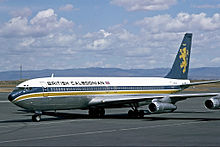Reasons for the failure of British Caledonian
[1] At the time, Sir Freddie Laker had begun building up BUA's scheduled route network in his capacity as that airline's managing director.
In those days very limited opportunities existed for wholly privately owned, independent airlines to provide fully fledged scheduled air services on major domestic and international trunk routes.
This resulted in a poor fit of many routes in BUA's network of scheduled services, thereby making it difficult to offer sensible connections that could be marketed to the travelling public.
[1] At the height of its commercial success in the late 1970s and early 1980s, BCal focussed on those routes that carried a very high proportion of profitable, oil-related, premium business traffic.
However, this initially successful strategy made the company dependent for most of its profits on a small number of markets whose fortunes were tied to the commodity price cycle, in unstable parts of the world, .
[5][6][7] For instance, the Civil Aviation Authority (CAA) had awarded BCal licences to launch fully fledged scheduled services from London Gatwick to New York's John F. Kennedy Airport (JFK), Los Angeles, Boston, Houston, Atlanta, Toronto and Singapore during the 1972 "Cannonball" hearings.
British Overseas Airways Corporation's resistance to opening the lucrative Far Eastern route to Singapore to home-grown competition by another British scheduled airline was so strong that BCal eventually only managed to obtain a renewable, three-months exempt charter permit, which entitled the airline to operate a small number of seat-only charter flights between Gatwick, Bahrain and Singapore.
[nb 3][7][11][12][13][14] In addition, the UK Government itself began to undermine the "Second Force" concept from the moment it decided to re-allocate BCal's unused Gatwick—JFK and Gatwick—Los Angeles International licences to rival independent airline Laker Airways, following Sir Freddie's high-profile, public campaign to get his proposed Skytrain off the ground.
[14][15] The "Second Force" concept was furthermore undermined when the Government overturned the CAA's refusal to grant British Midland a licence to begin domestic scheduled services on the two main trunk routes between London and Scotland from Heathrow, without giving BCal reciprocal access to that airport.
The conflict of interest that arose out of the UK Government's dual role as the sole owner of BA, at the time by far the largest British scheduled airline accounting for between three-quarters and four-fifths of the total output of Britain's entire scheduled air transport industry, as well as the regulator for all UK airlines meant that the interests of the "Second Force" were not always at the top of the Government's list of priorities.
[22] Restrictive bilateral air services agreements that had little or no scope for dual designation meant that BCal was effectively kept out of many markets for which it had already obtained licences from the CAA.
As Air France was the only airline the French government had designated to serve this route, this effectively meant that BA and BCal were compelled to share between themselves the 50% of the total capacity between London and Paris that had been allocated to the UK.
[26][27] This enabled it to offer a higher frequency on week days, resulting in a more competitive schedule for business travellers while keeping within its allocated capacity share.
The only way the Italian authorities agreed to BCal's request to add an additional Saturday frequency on that route was to compel the airline to enter into a pool agreement with Alitalia.
[nb 7] Bilateral restrictions seriously impeded BCal's efforts to successfully build a network of short-haul, European feeder services that was essential to provide sufficient transfer traffic for its long-haul routes from Gatwick.
[1][42] Heathrow's and Gatwick's respective geographic location as well as the number of people living within each airport's catchment area accounts for this difference in load factors, revenues and yields.
Back then, Heathrow's relative ease of access meant that it could attract a far greater number of travellers who were living or working in London than Gatwick.
Moreover, Heathrow's larger catchment area meant that it was able to offer more frequent flights to a greater number of destinations with more conveniently timed connections.
[19] It was further compounded by the fact that Gatwick had few connecting flights during the 1970s and early 1980s, as a result of the regulatory regime as well as the bilateral air services agreements the UK Government had negotiated with its overseas counterparts.
